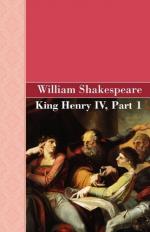|
This section contains 519 words (approx. 2 pages at 400 words per page) |

|
King Henry IV, Part I Summary & Study Guide Description
King Henry IV, Part I Summary & Study Guide includes comprehensive information and analysis to help you understand the book. This study guide contains the following sections:
This detailed literature summary also contains Further Study and a Free Quiz on King Henry IV, Part I by William Shakespeare.
Henry IV, Part One continues the story Shakespeare began telling in Richard II. To understand the events of Henry IV, Part One, readers must know that in Richard II, Henry IV, who was then known as Bolingbroke, returns from exile, has King Richard imprisoned, and declares himself King. In Henry IV, Part One, Henry's former supporters, those who helped put him in power, join forces against him. Henry and his son, Hal, fight together against the rebels. The story continues in Henry IV; Part Two with civil war still threatening the nation. Henry dies and Hal becomes King Henry V. Finally, in Henry V, the last of the group of plays known as the Lancastrian tetralogy (Lancaster refers to the family, or house, from which Henry was descended), Henry V conquers France, establishes peace, and marries Katherine, the French princess.
Scholars estimate that Henry IV, Part One was written and performed in late 1596 or early 1597. The play was published in 1598. For the historical plot of the play, Shakespeare drew from several sources of English history which were written during Elizabethan times. His primary source was Raphael Holinshed's Chronicles of England, Scotland, and Ireland (2nd edition, 1586-87). Shakespeare also consulted Samuel Daniel's narrative poem entitled The Civile Wars between the two houses of Lancaster and York (1595) and Edward Hall's Chronicle of the Union of the Two Noble and Illustre Famelies of Lancastre and Yorke (1540). Finally, Shakespeare seems to have drawn heavily from an anonymous play, The Famous Victories of Henry V (1594?), for the Hal-Falstaff plot.
Although little was written about the play until the mid-seventeenth century, when Samuel Pepys commented that the performance "did not please" him (Diary and Correspondence, 1660), it is known that Shakespeare was persuaded to change Falstaff's name, which was Jockey Oldcastle when the play was originally performed. When the play was first printed, the name had been changed. Scholars suggest that perhaps an Elizabethan descendent of the historical Oldcastle was offended by Shakespeare's representation of the family name.
The major conflicts in the play include Hal's strained relationship with his father. Henry IV is concerned that Hal is tarnishing his princely reputation with his association with the corrupt Falstaff. Falstaff is often associated with the idea of disorder, as his friendship with Hal appears to threaten the Prince's ability to mature into a responsible ruler. Critics argue whether Hal, who, after a confrontation with his father suddenly transforms himself into the prince his father wants him to be, was actually only using Falstaff to heighten the impact of his transformation. Others attempt to demonstrate Hal's sincerity.
Critics are also concerned with the rebellion against the crown and one of its chief instigators, Hotspur. The rebellion, led in part by Hotspur, threatens the stability and order of the nation. Hotspur's valor is admired by many in the play, especially by Henry, who suggests to Hal that Hotspur is perhaps a more deserving heir to the throne. Henry's comparison of the two often leads critics to do the same. Many commentators focus their comparison on the two distinct views of honor expressed by Hal and Hotspur.
Read more from the Study Guide
|
This section contains 519 words (approx. 2 pages at 400 words per page) |

|



